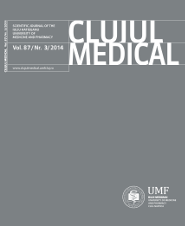Castleman disease. A report of six cases.
DOI:
https://doi.org/10.15386/cjmed-302Keywords:
Giant Lymph Node Hyperplasia, Interleukin-6, Herpesvirus 8, Human, ImmunohistochemistryAbstract
Abstract
Backgroud and aims: Castleman’s disease is a rare disorder situated at the boundary between reactive and neoplastic conditions. The pathogenesis is a subject of debate and the limited number of cases renders the study of the disease difficult.
In our paper we present a series of six case of Castleman disease with emphasis on clinical presentation, pathology examination and the use of immunohistochemistry in the final diagnosis of the cases.
Patients and method: Classification of the disease was based on clinical, imaging and pathological assesment. Specimens were obtained by surgical excission and were routinely processed for the pathology examination.
Results: All cases were unicentric disease. Two cases were locally extensive. The clinical symptoms were related mostly to compression effects. Five case were of the hyaline-vascular type and one was included in the plasma cell variant. One case showed angiomyoid differentiation.
Discussion: The histological aspect is highly sugestive of a chronic reactive process although some authors include the disease in the lymphproliferative disorders category. Chronic viral stimulation, especially Herpes virus 8 (HHV-8, Kaposi sarcoma virus) infection, the IL-6 signaling cascade, angiogenesis and clonal rearangements play a role in the pathogensis of CD.
Conclusions: We strongly belive that by understanding the pathogenesis of the precursor lessions we will gain better understanding of the pathways that lead to neoplasia and that Castleman disesase is a very interesting „natural experiment” ilustrating the progression from chronic antigen stimulation to reactive lymphoid hyperplasia and finally to overt lymphoid neoplasia.
Downloads
Published
How to Cite
Issue
Section
License
The authors are required to transfer the copyright of the published paper to the journal. This is done by agreeing to sign the Copyright Assignment Form. Whenever the case, authors are also required to send permissions to reproduce material (such as illustrations) from the copyright holder.

The papers published in the journal are licensed under a Creative Commons Attribution-NonCommercial-NoDerivatives 4.0 International License.

